Overview: Alice Queen Ltd (“Alice Queen”, “the Company”) is an Australian minerals company focused on gold and base metal exploration in New South Wales (“NSW”) and Queensland. Its flagship asset is the Horn Island Gold Project (84.5%), which incorporates an abandoned open-cut mine site located in the Torres Strait, recently relinquished from 25 years of State Government control. The Company also holds the Looking Glass Project in NSW. Alice Queen listed on the Australian Securities Exchange (“ASX”) in November 2015 via a reverse takeover (“RTO”) with Callabonna Resources Ltd (ASX:CUU).


Catalysts: Guided by the principal discoverer of the prolific Cadia Valley deposits, Alice Queen is preparing for a maiden drilling program at its Looking Glass Project. Believed to incorporate a buried northern extension of the Molong Volcanic Arc, Looking Glass has not previously been subject to exploration at the basement rock level for gold or base metal mineralisation. Two exploration holes over the coming months, co-funded by the NSW Government, offer high-impact value drivers.
Hurdles: Upcoming exploration drilling at Looking Glass is subject to placement completion, high technical risk and there is no guarantee economic mineralisation will be encountered. Alice Queen is reliant on external capital and there is no guarantee it can procure additional funding. Considerable further capital and technical investigations are required to establish the feasibility and economic merit of a mining development at Horn Island. There is no guarantee Alice Queen can
overcome the technical and financial challenges preempting the closure of the Horn Island Gold Mine in 1989.

Investment View: Alice Queen offers speculative exposure to gold and base metal markets through a combination of exploration assets covering known mineralised structures and grassroots opportunities. The exploration record of its technical team and upcoming activity at Looking Glass are attractive qualities, whilst Horn Island represents a strategic exploration asset in the Torres Strait. Principal risks are funding beyond the current programs and technical exploration risks. With upcoming high-impact drilling at Looking Glass representing the major near-term value driver, we are initiating coverage.
Alice Queen Ltd (“Alice Queen”, “the Company”) is an Australian minerals company focused on gold and base metal exploration in New South Wales and Queensland.

Its flagship asset is the Horn Island Gold Project (84.5%), which incorporates an abandoned open-cut mine site located in the Torres Strait, recently relinquished from 25 years of State Government control. Alice Queen also holds the Looking Glass Project, a greenfield exploration asset in central NSW.
Alice Queen was incorporated in February 2012, and listed on the Australian Securities Exchange (“ASX”) in November 2015 via a reverse takeover (“RTO”) with Callabonna Resources Ltd (ASX:CUU). Following the transaction, issued capital stands at $4.7million, or $0.024/share.
The Horn Island Gold Project (“Horn Island”) consists of two granted exploration licences in the Torres Strait, approximately 800 km north-north-west of Cairns in Northern Queensland. The main licence (EPM25520; “Ngurupai”) covers an area of 81km2 incorporating the majority of Horn Island. A second licence (EPM25418; “Kaiwalagal”) covering 249km2 over the neighbouring Prince of Wales group of Islands was granted in March 2016.
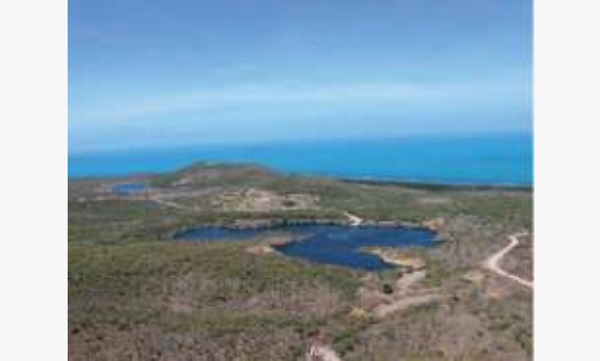
Alice Queen’s interest in the Horn Island Project is 84.5%. Other interests include the Kaurareg Aboriginal Land Trust (“KALT”; 7.5%) and the Company’s founders (8%). Interests of KALT and the founders are subject to a free carry-through to commercial production.
Horn Island is a brownfield’s project, incorporating an abandoned open pit that was mined between 1987-89. Certified resources have yet to be defined.
The Horn Island Project is situated mainly within open tropical eucalypt woodland or forest and is serviced by existing road and electricity infrastructure.
With the area acting as a waypoint for shipping in and out of Weipa, service facilities in the area are good and include, but are not limited to, 4G mobile, heavy earth moving equipment contractors, mechanical and electrical service contractors, hospital, housing, and an airport.
The presence of gold mineralisation at Horn Island has been documented over more than a century but witnessed no exploration or development for the past twenty-five years.
Alice Queen is Horn Island’s first exploration licencee in 25 years
Gold was first discovered on Horn Island by Smyth and party in 1894. Numerous, independent prospecting and mining campaigns were initiated during the following three decades. The most substantial was the Horn Island Gold Mining Company which floated in 1899 and constructed an industrial processing mill.
Cumulative production during this era is estimated to have been in the order of 10,000oz. Subsequently, Horn Island has witnessed at least 12 additional independent exploration campaigns, although there are no further production records up until the late 1980s.

After twenty five years of Government imposed restriction’s, Horn Island is once again open for gold exploration
In 1984, AuGold NL acquired an option over the Horn Island Project, and over the following three years conducted a three-phase drilling program consisting of over 400 percussion drill holes.
Results of the program formed the basis of a feasibility study, incorporating a mining reserve of 2.4Mt grading 2.37g/t (~0.18moz). A Joint Venture to develop an open-cut mining operation alongside a 0.65Mt pa processing plant was established with Giant Resources Ltd in 1987.
Production commenced in 1988, however, the mine was abandoned in December 1989 due to the bankruptcy of Giant Resources Ltd. It is estimated that Giant mined and milled ~640,000 tons at 1.6 g/t Au. The mining depth of the open cut was reported to have reached 31 metres below the current water level.
Ore dilution from mining the narrow, near-vertical veined gold mineralisation was one of the main early problems causing the operation to lose money – increased waste stripping also contributed. The grade delivered to the plant was reported as 1.7 g/t against an expected grade of 2.37 g/t.
Subsequent to its abandonment, a Restricted Area declaration (RA295) was placed over the Horn Island Gold Mine by the Queensland Government. This followed the failure of the mine owner to fulfil its obligations regarding rehabilitation of the site after the mine closed.
On its declaration, RA295 prohibited any further exploration or mining activities on Horn Island and the Queensland Government undertook its own rehabilitation program over the area.
Restrictions remained in force over the Horn Island Gold Mine until December 2013, when Alice Queen’s subsidiary, Kauraru Gold successfully lobbied the Queensland Government to have RA295 repealed after nearly three decades.
After successfully lobbying for the repeal of State Government restrictions over the Horn Island Mine, Alice Queen secured an exploration licence covering the site in October 2014. Central to these accomplishments are the interests of local landowners, which are served by a free carried 7.5 percent interest in any future mining development.
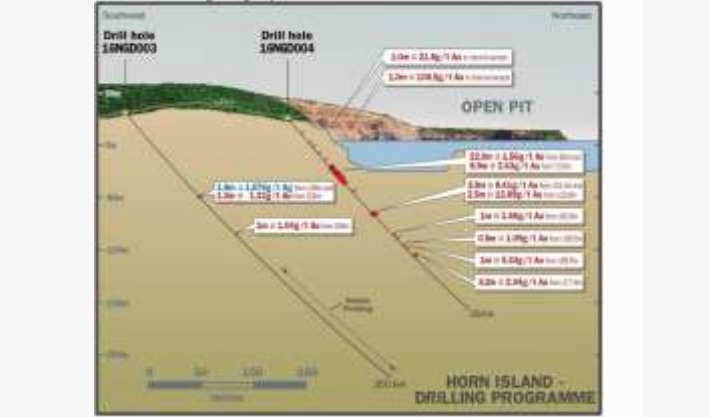

Alice Queen has subsequently focused on exploration incorporating the former open pit and surrounding locale. Historical drilling records (536 holes for 8,077metres) were utilised to guide a rock and channel sampling program in November 2014. Incorporating the southern wall of the old open pit, samples of up to 1m at 106g/t Au and 220g/t Au, these sampling results provided impetus for a 14-hole, 3,660metre diamond drilling program during 2016.






Sampling over circa 1/3rd of the Island has significantly expanded gold targets beyond the former open pit
The drilling program was designed to test the continuity of mineralisation below the abandoned open pit at depths of 200metres. Drilling indicated the orebody to be truncated at depth by a basal fault. This structure dips to the northwest from a depth of approximately 30m in the east to 230m depth at the western limit of drilling. Alice Queen commissioned a surface sampling program to identify other occurrences of gold mineralisation outside the historic pit area.
The sampling program has incorporated approximately 1/3 rd of the Island. Results have expanded the Company’s gold exploration targets beyond the former open pit, which are due to be appraised via a second round of exploratory drilling over the coming weeks.
Second round of drilling is imminent
Whilst Alice Queen has sufficient funding to complete upcoming drilling, we note that a future resource delineation drilling program is beyond the scope of Alice Queen’s current capital budget, and hence will require additional funding.
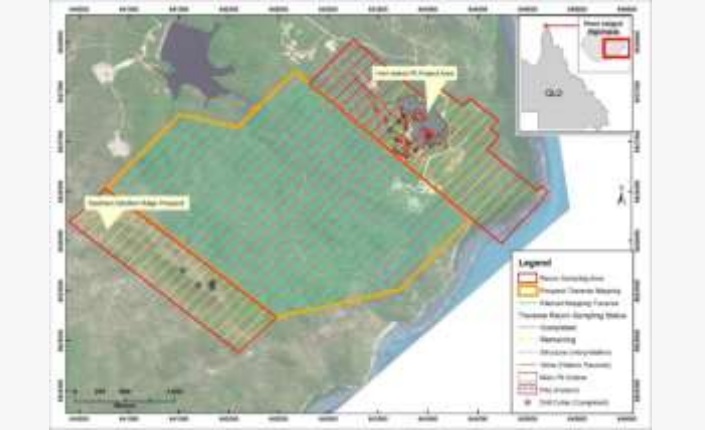

As Alice Queen is currently developing a geological model to support resource certification, there is presently insufficient data to establish the potential economics of a new mining campaign.
Resource certification is required to determine economics
If a mineral resource is certified, the Company must conduct scoping and feasibility studies to determine mine design, operating, and capital costs. Whilst such initiatives are presently beyond the scope of Alice Queen’s capital resources, we understand that services and infrastructure in the region may be conducive for modern mining development.






Horn Island benefits from modern services and infrastructure, much of which would not have been available for AuGold in the late 1980’s
Adjacent Thursday Island acts as a waypoint for shipping in and out of Weipa – one of the world’s largest bauxite mines. Due to its strategic positioning in Northern Australia, the area is also host to numerous institutional outposts serving defence and customs interests.
Service facilities in the area are therefore good and include, but are not limited to, 4G mobile, heavy earth moving equipment contractors, mechanical and electrical service contractors, hospital, housing, and an airport.
Horn Island itself hosts an airport served by twice-daily flights from Cairns and a deep water port with twice-weekly container services from Cairns. Legacy infrastructure from the former Horn Island Gold Mine includes the now flooded open pit process water pond and rehabilitated plant site.
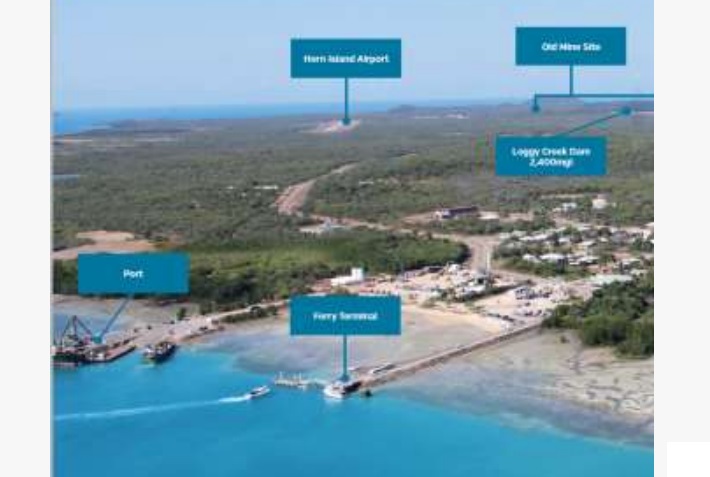

The Looking Glass Project (“Looking Glass”) consists of one granted exploration licence in New South Wales, approximately 30km northwest of Coonabarabran and approximately 300km north-West of Sydney. The granted licence (EL8225) covers an area of 216km2 and was recently renewed for a period of two years commencing January 2016. Application for a second licence has been lodged (ELA5207; “Mendooran”).
Alice Queen’s interest in Looking Glass is 90%. Other interests are held by founders of the Looking Glass Project, incorporating Andrew Buxton (2%), Mark Kerr (2%), John Holliday (4%), and Bruce Fulton (2%). These founding interests are subject to a free carry through to commercial production.


Looking Glass is a greenfield project, subject to no previous exploration at the basement rock level for gold or base metal mineralisation. Certified resources have yet to be defined.
The Looking Glass Project is situated mainly within cleared and non-cleared grazing and pastoral land and is well serviced by existing road and electricity infrastructures and both are easily accessible from nearby Coonabarabran.
Service facilities in the area are excellent and include, but are not limited to, heavy earth moving equipment contractors, mechanical and electrical service contractors, hospitals, construction companies, significant residential housing, and commercial regional airports.
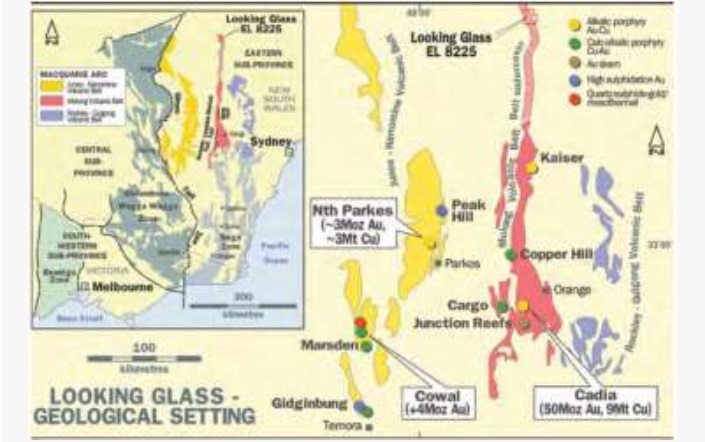

Cadia Valley hosts more than 1/3rd of the gold reserves controlled by Australia’s largest gold producer, Newcrest Mining Ltd (“Newcrest”, NCM.ASX). Developed during the 1990s, the Cadia Valley Operations hosted Australia’s second-largest open-pit mine until its conversion to a completely underground mine in the last few years.
Opened in 2014, the Cadia East panel cave is the largest metalliferous underground mine in Australia, and one of the largest in the world. The panel cave mine was developed at a capital cost of $2billion and is scheduled to have operating costs in the gold mining industry’s lowest quartile.






Chief Technical Advisor, John Holliday, was a principal discoverer and site manager of the Cadia porphyry goldcopper deposits.
The Cadia East panel cave is being operated at depths of between 1200metres and 1500metres below the surface. The deposit is scheduled to support a 30-year mine life but is not the only underground orebody to be developed by Newcrest as part of its Cadia Valley operations.
Similarly deep, less than 10km westward, lies the Ridgeway deposit. Discovered in 1996 and subsequently developed as a standalone underground caving operation, the Ridgeway deposit commences 500metres from the surface.
Whilst Cadia East’s identification leveraged surface expressions associated with the former open pit mine, Ridgeway was a ‘blind’ discovery with no surface mineral expressions.


Targeting Cadia style copper-gold porphyry deposits
The potential for similar basement rocks to underlay the Looking Glass Project is the foundation for Alice Queen’s interest in the asset. Alice Queen’s exploration thesis surrounding Looking Glass has been developed by Chief Technical Advisor – John Holliday, who retains a 4% free carried interest in the project.
During their tenure as Chief Geoscientist and General Manager, Property Generation at Newcrest, John was a principal discoverer and site manager of the Cadia porphyry gold-copper deposits.
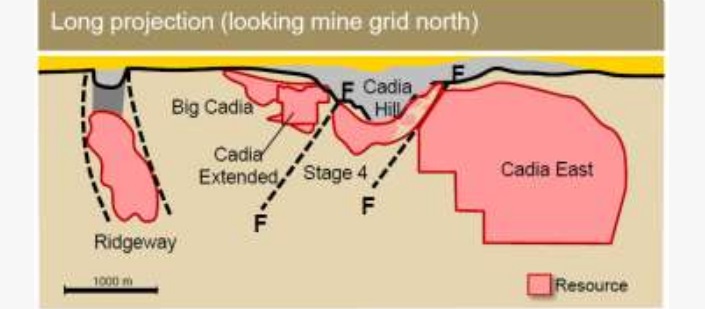

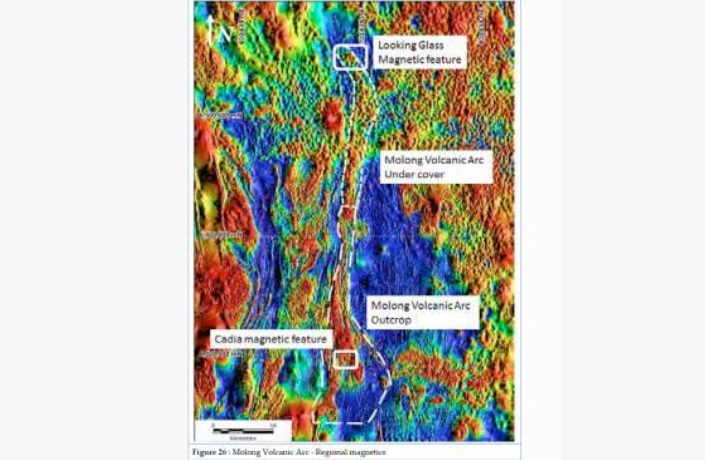

The geological formation hosting the Cadia Valley deposits is known as the Molong Volcanic Arc. The southern part of this formation – where it outcrops or overburden is shallow – has been subject to extensive exploration.
Alice Queen’s exploration thesis is that the northern part of this formation is equally prospective, yet unexplored due to an absence of an outcrop.


The Looking Glass Project is believed to incorporate a northern extension of the Molong Volcanic Arc. It has not previously been subject to exploration at the basement rock level for gold or base metal mineralisation.






Looking Glass has never been explored for gold or base metals in its underlying basement rocks
Since acquiring the exploration licence in January 2014, Alice Queen has completed a historical data review and commissioned a closed-spaced airborne magnetics survey in February 2015.
The Company has overlaid magnetic features outlined by the survey against its understanding of the Molong Volcanic Arc’s likely depth profile to generate targets that could host porphyry copper-gold deposits.
Whilst this exploration strategy yields a good probability that the magnetic anomaly is caused by mineralised intrusive rocks, the probability of these rocks hosting mineralisation of the scale and form to be an economic deposit is quite rare.
Alice Queen is therefore balancing the ‘high impact’ nature of exploration at Looking Glass against the associated success rates and capital requirements.
The next phase of exploration at Looking Glass requires a 700m RC/Core hole to test the potential porphyry carapace zone in basement rocks above one of the identified deep magnetic features.
Following a capital raising in July, and subsequent $190,000 NSW Government Grant, Alice Queen is planning to drill two holes at Looking Glass during 2016.
As part of the Looking Glass exploration licence falls within a Mining Reserve, future exploration activities will need to comply with regulations surrounding surface disturbances, noise, and dust.
As Alice Queen’s assets are currently in the exploration phase, the Company does not presently generate revenue and is reliant on external capital to fund operations.
Prior to its RTO transaction with Callabonna Resources Ltd, Alice Queen incurred losses of $0.16million for the nine months to March 2015. Since the RTO transaction, Alice Queen incurred expenses totaling $0.5million in the December quarter and reported cash reserves of $2.5million.
$0.9m cash balance as of Jun 30th
To date, Alice Queen has financed operations via equity. The November RTO transaction raised $3.5million at $0.055/share. Including vendor consideration shares the RTO transaction increased shares outstanding by 10-fold.
Alice Queen’s latest equity raising is a $0.8million placement at $0.03/share. The placement is accompanied by a one-for-one option exercisable at $0.03/share within 12 months. Following shareholder approval on September 9th, the placement is currently underway.
After the placement, we estimate issued capital stands at $5.8million, or $0.026/share.
We understand that future equity and debt contributors to support a new mining development are scheduled to be compensated for free carrying minority shareholders in the Horn Island Project.
In that regard, free carried interests must repay their share of capital expenditure out of any future cash flow, with dividends applied 80:20 in favour of debt repayment until all capital costs have been repaid.


Alice Queen offers speculative exposure to gold and base metal markets through a combination of exploration assets covering known mineralised structures and grassroots opportunities.
Looking Glass is a grass roots exploration project
We are attracted to the exploration record of its technical team, and the value potential which upcoming drilling could deliver. The Company’s ability to secure funding and successfully execute last year’s RTO amid very challenging capital market conditions for exploration stage properties is a testament to its team and the potential of its portfolio.
Whilst recent exploration drilling at Horn Island has impacted investor confidence, the asset remains strategic for regional exploration in the Torres Strait. Upcoming activity across Alice Queen’s portfolio could galvanise interest towards the stock if outcomes are technically favourable.


Looking Glass drilling is the major value driver
The Company’s ability to secure additional funds to execute additional drilling beyond current programs is a principal risk. Other risks include its capacity to identify economic mineralisation, engineer a technically and financially sound development plan, whilst complying with local regulations and customs at Horn Island and Looking Glass.
With the Looking Glass drill program being the major near-term value catalyst, we are initiating coverage.
Phillip Harman is a geophysicist on the board of several ASX-listed mineral exploration companies, with over 30 years of experience working for market-leading BHP Billiton.
At BHP, Phillip specialised in minerals exploration. He worked in Australia and South America in both technical and managerial roles including Chief Geophysicist, Manager of Discovery Technology, and Exploration Manager. Through his international experience, Phillip has broad networks in the global mining, business development, and exploration communities.
With expertise in creating and managing junior exploration companies, as well as an extensive understanding of capital markets, Phillip has raised capital for exploration through the ASX and the AIM in London. Phillip was also the Managing Director of ASX-listed Gravity Diamonds Limited for five years until its acquisition in 2007.
Andrew was previously Managing Director of Kidman Resources Limited [ASX: KDR] an ASX listed base metals and rare earth elements explorer in New South Wales and Northern Territory. Kidman Resources listed on the ASX in January 2011 and was ranked as the fifth best performing IPO by price appreciation, by Deloitte Touche Thomatsu in its Annual IPO Report 2011. Before this Andrew was co-founder and Executive Director of Media Entertainment Group Limited, which specialised in screen advertising. Media Entertainment Group was ASX listed and operated in six countries before being acquired by Consolidated Press Holdings.
Mark is Chairman of Contango Microcap Limited (appointed 7 December 2009), is a non-executive director of Contango Income Generator Limited, appointed 1 July 2013, and is a non-executive Chairman of Think Childcare Limited (appointed June 2014). He is Chairman of both Hawthorn Resources Limited (appointed 22 November 2007) and Australian Seafood Investments Limited (unlisted public company, appointed 17 November 2014).
Mark specialises in public relations and reputation management consultancy and has served on a number of public company boards. He is currently a director of Berkeley Consultants, a public relations and reputation management consultancy. Mark was responsible for the launch and publication of the National Directory of Aboriginal and Torres Strait Islander Organisations directory, this directory is the first of its kind in Australia in 1992.
There is no guarantee Alice Queen’s exploration programs can successfully delineate mineral resources of sufficient grade and scale to support a modern mining operation. With historic mineralisation reported to be ‘nuggetty’ in nature, the reliability of future mineral resource and reserve estimations may suffer.
Gold and base metal prices have witnessed several years of contraction. Continuation of the trend or failure of these markets to recover could impair the economic value of exploration programs being implemented by Alice Queen.
Ongoing exploration and subsequent development activities at the Horn Island Gold Project are contingent on the support of local landowners – the Kaurareg Aboriginal People. Whilst local interests are represented by KALT’s 7.5 percent free carried project shareholding, any deterioration in relations between Alice Queen and the Kaurareg Aboriginal People could impede the Company’s ability to operate in the area.
Alice Queen is reliant on external capital and there is no guarantee it can procure the necessary funding required to further advance the Horn Island Gold Project and Looking Glass Project. The upper range of Alice Queen’s exploration target requires drilling beyond the scope of its current program and existing cash reserves.
Alice Queen’s mineral assets are presently not yet sufficiently advanced to ascribe a valuation with any degree of confidence. A fair price for its shares is therefore difficult to determine.
Management is incentivized through shares in Alice Queen as well as free carried interests in both the Horn Island Project and Looking Glass Project. Whilst this structure is intended to align stakeholder interests, it may not create appropriate incentives to develop the assets with minimal possible dilution for Alice Queen shareholders.
Approximately 46 percent of the Looking Glass Project falls within lands classified as Mining Reserve, which may restrict the Company’s capacity to develop and operate on the land.


THE BULLS SAY


THE BEARS SAY
S3 Consortium Pty Ltd (CAR No.433913) is a corporate authorised representative of LeMessurier Securities Pty Ltd (AFSL No. 296877). The information contained in this report is general information only. Any advice is general advice only. Neither your personal objectives, financial situation nor needs have been taken into consideration. Accordingly you should consider how appropriate the advice (if any) is to those objectives, financial situation and needs, before acting on the advice.
Conflict of Interest Notice
S3 Consortium Pty Ltd does and seeks to do business with companies featured in its reports. As a result, investors should be aware that the S3 Consortium may have a conflict of interest that could affect the objectivity of this report. Investors should consider this report as only a single factor in making any investment decision. The publishers of this report also wish to disclose that they may hold this stock in their portfolios and that any decision to purchase this stock should be done so after the purchaser has made their own inquires as to the validity of any information in this report.
Publishers Notice
The information contained in this report is current at the finalised date. The information contained in this report is based on sources reasonably considered to be reliable by S3 Consortium Pty Ltd, and available in the public domain. No “insider information” is ever sourced, disclosed or used by S3 Consortium.